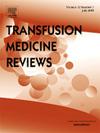Optimizing Buffy Coat Pooling: Enhancing Platelet Yield Through Platelet Count-Based Sorting
IF 2.5
2区 医学
Q2 HEMATOLOGY
引用次数: 0
Abstract
Optimizing platelet yield in pooled buffy coat (BC)-derived platelet products by sorting them according to donor whole blood (WB) platelet counts is a promising approach to increase the production of double-dose platelet concentrates while reducing the variability among products. We aimed to assess the benefit of sorting according to an HTML-report generated by an in-house developed preselection algorithm. In this study, we compared two approaches of BC pooling to produce pathogen-inactivated double-dose platelet concentrates. The platelet count of donor WB was measured using a hematology analyzer prior to pooling. In one group, six BCs were randomly assigned to pools, while in the other group, six BCs were sorted by platelet counts of WB samples prior to pooling according to an in-house developed preselection algorithm, selecting six BCs for each pool in a way that yields for each product are similar. All BCs were included as no minimum or maximum platelet count entry criteria were used. Yield and divisibility rate of both approaches were compared using Wilcoxon Rank−Sum Test to assess the impact of sorting by platelet count. Sorting BCs according to our in-house developed algorithm resulted in significantly higher median platelet concentrations (×10³/µL), rising from 1247 (interquartile range [IQR] 1207-1349) when randomly assigned to 1307 (IQR 1237-1381) when sorted (P = .0434). In line, yields per platelet unit (×1011/unit) significantly increased from 4.6 (IQR 4.3-4.8) when randomly assigned to 4.8 (IQR 4.5-5.1) when sorted (P = .0191). The proportion of divisible pathogen-inactivated platelet units increased from 72.1% to 89.5%. For both approaches, all units were above the minimum threshold (>2.0 × 1011/unit) and no maximum threshold was defined. Assigning BCs to pools according to an in-house developed preselection algorithm enables the production of platelet concentrates with increased yields and leads to more standardized products.
优化褐皮池:通过血小板计数分选提高血小板产量
根据供者全血(WB)血小板计数进行分选,从而优化淡褐色外套(BC)衍生血小板产品的血小板产量,是一种很有前途的方法,可以增加双剂量血小板浓缩物的产量,同时减少产品之间的可变性。我们的目的是根据内部开发的预选算法生成的html报告来评估排序的好处。在这项研究中,我们比较了BC池生产病原体灭活双剂量血小板浓缩物的两种方法。在入池之前,使用血液学分析仪测量供体WB的血小板计数。在一组中,6个bc被随机分配到池中,而在另一组中,根据内部开发的预选算法,在池前根据WB样本的血小板计数对6个bc进行排序,以每种产品的产量相似的方式为每个池选择6个bc。没有使用最小或最大血小板计数的入组标准,因此纳入了所有bc。采用Wilcoxon秩和检验比较两种方法的产率和可分率,以评估血小板计数分选的影响。根据我们自己开发的算法对bc进行排序,结果血小板浓度中位数(×10³/µL)显著提高,从随机分配时的1247(四分位间距[IQR] 1207-1349)上升到随机分配时的1307 (IQR 1237-1381) (P = 0.0434)。与此同时,每血小板单位产量(×1011/单位)从随机分配时的4.6 (IQR 4.3-4.8)显著增加到排序时的4.8 (IQR 4.5-5.1) (P = 0.0191)。可分病原灭活血小板单位比例由72.1%上升至89.5%。两种方法均高于最小阈值(>;2.0 × 1011/单位),未定义最大阈值。根据内部开发的预选算法将bc分配到池中,可以提高血小板浓缩物的产量,并导致更标准化的产品。
本文章由计算机程序翻译,如有差异,请以英文原文为准。
求助全文
约1分钟内获得全文
求助全文
来源期刊

Transfusion Medicine Reviews
医学-血液学
CiteScore
11.60
自引率
0.00%
发文量
40
审稿时长
21 days
期刊介绍:
Transfusion Medicine Reviews provides an international forum in English for the publication of scholarly work devoted to the various sub-disciplines that comprise Transfusion Medicine including hemostasis and thrombosis and cellular therapies. The scope of the journal encompasses basic science, practical aspects, laboratory developments, clinical indications, and adverse effects.
 求助内容:
求助内容: 应助结果提醒方式:
应助结果提醒方式:


